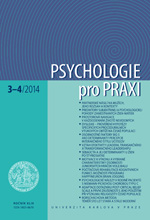Adaptace dotazníku Post-Critical Belief Scale a první zkušenosti s jeho použitím při výzkumu religiozity české populace
Adaptation of Post-Critical Belief Scale questionnaire, and first experience with its use during religiosity research in Czech population
Author(s): Renata HacklováSubject(s): Psychology
Published by: Univerzita Karlova v Praze, Nakladatelství Karolinum
Keywords: religiosity; spirituality; approaches to religion; mental health; conviction; social support; locus of control; gratefulness; Belgium
Summary/Abstract: The first aim of the study was to examine psychometrics of a Czech pilot version of the PCBS-short, the second aim was to test differences in scores between four religious attitudes and selected psychosocial aspects of personality. The sample consisted of 278 adults (104 men and 174 women, average age 41.9 years). Methods: The Czech pilot version of Post-critical belief scale-short (PCBS-short) was used to measure Wulff’s religiosity dimensions. To measure some aspects of positively defined mental health the following methods were selected: WHOQoL-BREF (measure for quality of life), SOC (sense of coherence, integrity), PSSS (perceived social support), and GQ 6 (dispositional gratitude), LOC (locus of control). The principal component analysis confirmed two componential solutions. The structure of PCBS-short scale consists of two dimensions and four subscales. Four groups of religious attitudes (Orthodoxy, External Critique, Relativism, and Second Naiveté) were described on the basis of standard z-scores and two couples out of four quadrants were selected and compared. Results of the study showed that none of the religion dimensions were proved as a significant predictor of quality of life. People in Second Naiveté quadrant had significantly better satisfaction with life, perceived social support and gratitude than people in External Critique quadrant. People in Second Naiveté quadrant had significantly better quality of life, satisfaction with life, sense of coherence and gratitude than people in Orthodoxy quadrant.
Journal: Psychologie pro praxi
- Issue Year: 2014
- Issue No: 3-4
- Page Range: 153-170
- Page Count: 18
- Language: Czech

